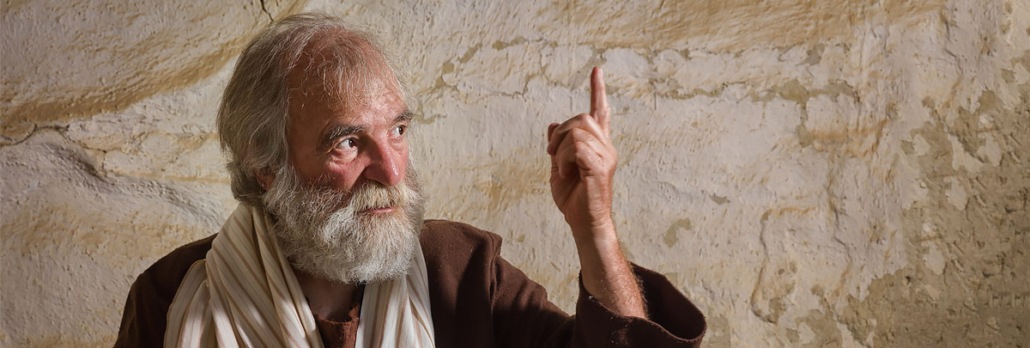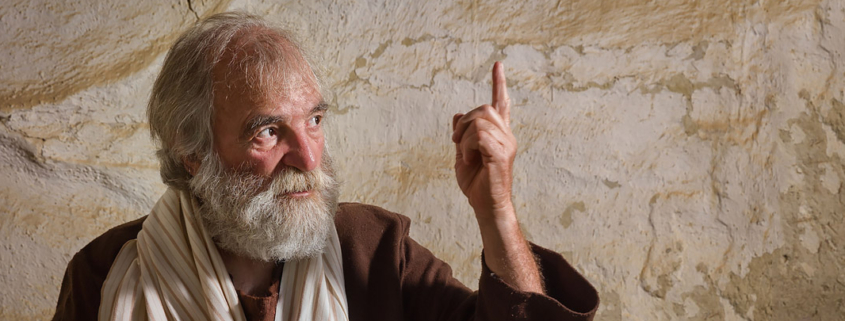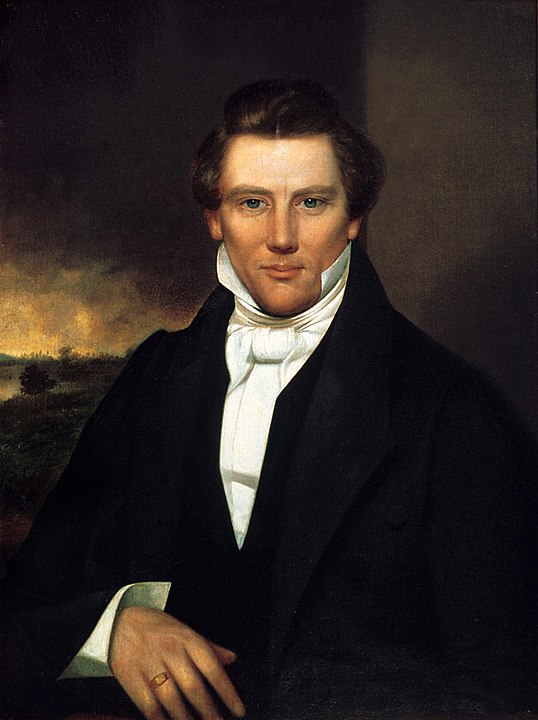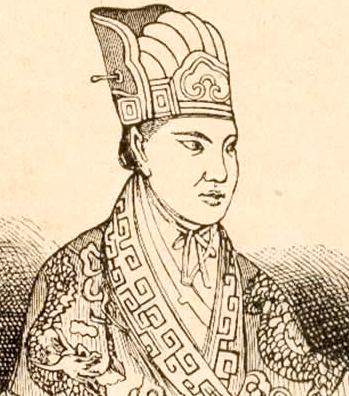House of the Prophets

19 The weak things of the world shall come forth and break down the mighty and strong ones, that man should not counsel his fellow man, neither trust in the arm of flesh— 20 But that every man might speak in the name of God the Lord, even the Savior of the world; (D&C 1:19–20)
And again, verily I say unto you, I would that ye should always remember, and always retain in your minds what those gifts are, that are given unto the church… For to some is given one, and to some is given another, that all may be profited thereby… to some is given the working of miracles; and to others it is given to prophesy… (D&C 46:10–22)
8 Wherefore, I will that all men shall repent, for all are under sin, except those which I have reserved unto myself, holy men that ye know not of. (D&C 49:8)
A. They are two prophets that are to be raised up to the Jewish nation in the last days, at the time of the restoration, and to prophesy to the Jews after they are gathered and have built the city of Jerusalem in the land of their fathers. (D&C 77:15)
In Mormonism, we sometimes forget our prophetic roots and confuse the concept of the prophetic leading high priest (of which there is only one per priesthood sect – D&C 107), and a prophet (of which there can be many). Mormonism was not just started by Joseph Smith, but by a whole group of individuals with a prophetic or mystical worldview. Scores of people who regularly saw visions and believed in prophetic ability. To be a prophet or prophetess in Mormonism was not a privilege reserved for the Pope or people of the scriptures, but a right that came with faith and good works. It was a body of people who believed they received revelation from heaven in order to start religious movements which could stand as the cornerstones of upcoming philosophical thought for the new age.
Through the years, the Mormon movement continues to be a ‘house of the prophets’. Not just with leaders who believe themselves capabable of revelation from heaven, but by scores of visionaries who have been raised under the faith. Sometimes these visionaries, mystics and prophets have stayed within the faith… and sometimes they have broken off to form their own sects. But regardless, they are a continuation of an ancient tradition of people who believe themselves moved upon by divinity to change the course of the world.
Prophets of the Second Great Awakening
Many LDS people don’t realize that Joseph Smith’s first vision experience was not entirely unique. Many individuals both in recent and ancient times have had experiences with what they believe are angels and deity. Many of the worlds largest religions are the result of such experiences. Many smaller faiths within the mysticism movement have a long history of having and analyzing these types of experiences (see this article for a discussion on this).
“Theophany” (θεοφάνεια/theophaneia) is the word coined by the ancient Greeks to describe the appearance of a deity to a human. This term has been used to refer to appearances of the gods in the ancient Greek and Near Eastern religions. While the Iliad is the earliest source for descriptions of theophanies in the Classical tradition/era (and they occur throughout Greek mythology), probably the earliest historically dated description of a theophany is in the Epic of Gilgamesh. Similar experiences have continued throughout recorded history.
In the Book of Oahspe the idea is proposed that true prophets RARELY come as isolated instances; because they are the product of powerful heavenly forces which send THOUSANDS of influencers to all parts of the world simultaneously to affect human events. Indeed, this is supposedly one of the ways people can know whether a movement/inspiration is sourced in the higher more powerful heavens, or just by random un-exalted spirit beings. Because it will show up an inspirational movements among multiple cultures simultaneously. This is relevent in Mormonism, as the Joseph Smith was but one grand player, in many ‘prophets’ of the Second Great Awakening. The following is a list of theophanies, ordered by their relevance to Mormonism.
Joseph Smith (December 23, 1805 – June 27, 1844), was an American religious leader and founder of Mormonism and the Latter Day Saint movement. When he was 24, Smith published the Book of Mormon. By the time of his death, 14 years later, he had attracted tens of thousands of followers and founded a religion that continues to the present with millions of global adherents.
Smith was born in Sharon, Vermont. By 1817, he had moved with his family to western New York, the site of intense religious revivalism during the Second Great Awakening. Smith said he experienced a series of visions, including one in 1820 during which he saw “two personages” (whom he eventually described as God the Father and Jesus Christ), and another in 1823 in which an angel directed him to a buried book of golden plates inscribed with a Judeo-Christian history of an ancient American civilization. In 1830, Smith published what he said was an English translation of these plates called the Book of Mormon. The same year he organized the Church of Christ, calling it a restoration of the early Christian church. Members of the church were later called “Latter Day Saints” or “Mormons”, and Smith announced a revelation in 1838 which renamed the church as the Church of Jesus Christ of Latter Day Saints.
Hong Xiuquan (Jan 1814 – June 1864), was a Hakka Chinese prophet/leader of the Taiping Rebellion against the Qing Dynasty, establishing the Taiping Heavenly Kingdom of Peace over varying portions of southern China.
In 1837, Hong reported being visited by two figures, an old, paternal figure and an elder brother-figure who he later described as God the Father and Jesus Christ. In the vision the old man [Father] complained to Hong about men worshiping demons rather than him. In a second vision, Hong saw Confucius being punished for his faithlessness, after which he repented. In another dream, Hong dreamt of angels carrying him to heaven, where he met the elder-brother figure [Jesus] wearing a black dragon robe with a long golden beard who gave him a sword and a magic seal, and told him to purge China of its demons. Much like Joseph Smith in America, started a church which he called ‘the heavenly kingdom’ and instituted polygamy as well as a form of ‘consecration’ or communism. Hong’s religion or ideology was broken up when his rebellion was destroyed by Chinese imperial forces in the Taiping Rebellion, and his followers put to death. (Deaths from the Rebellion are estimated at between 20-70 million). Without the the foundation of individual freedom and independence which the United States environment gave Joseph Smith’s movement, Hong’s promotion of consecration ended up being more extreme than that of the Latter-day Saint movement. His legacy lived on, and became a major basis for the later popularity of the Communist revolutions of China.

The Báb, whose birth name was Sayyed ʿAli Muhammad Shirāzi (October 20, 1819 – July 9, 1850) was the founder of Bábism, and one of three central figures of the Bahá’í Faith (~8 million adherents). He was a merchant from Shiraz in Qajar Iran who, at the age of twenty-four (on the evening of May 22, 1844), claimed to be an inspired interpreter of the Qur’an within the Shaykhi school of Twelver Shi’ism. In a series of several stages, he first introduced himself as the Báb (meaning “Gate” or “Door”) to the Promised Twelver Mahdi or al-Qá’im, then the Mahdi himself, then the Prophet of a New Age, and finally, as the essence of God and his being.
Bahá’ís claim that the Báb was also the spiritual return of Elijah and John the Baptist, that he was the saoshyant referred to in Zoroastrianism,[3] and that he was the forerunner of their own religion. Bahá’u’lláh, the founder of the Bahá’í Faith, was a follower of the Báb and claimed to be the fulfillment of his promise that God would send another messenger. In 1850, at the age of thirty, the Báb was shot by a firing squad in Tabriz.
Mirzā Ghulām Ahmad (13 February 1835 – 26 May 1908) was an Indian religious leader and the founder of the Ahmadiyya Movement in Islam (~20 million adherents). He claimed to have been divinely appointed as the promised Mahdi, in the likeness of Jesus (mathīl-iʿIsā),[1][2] in fulfillment of Islam’s eschatological prophecies, as well as the Mujaddid (centennial reviver) of the 14th Islamic century.
When he was just over forty years of age, his father died and around that time he believed that God began to communicate with him. He claimed countless dreams and visions from God. In 1889, he took a pledge of allegiance from forty of his supporters at Ludhiana and formed a community of followers upon what he claimed was divine instruction, stipulating ten conditions of initiation. Ghulam Ahmad was a prolific author and wrote more than ninety books on various religious, theological and moral subjects between the publication of the first volume of Barahin-i-Ahmadiyya (The Proofs of Islam, his first major work) in 1880 and his death in May 1908. In addition to the claim of being God’s Messenger and “god or one with God” Mirza wrote, of one particular theophany as follows,
“I saw God Almighty personified as a human being in a vision. He put His arm round my neck and said [Punjabi]: If you will be devoted to Me, the whole world will be yours.” (from Tadhkirah, page 609, page 571 in the hardcopy)
By the time of his death, he had gathered an estimated 400,000 followers, especially within the United Provinces, the Punjab and Sindh and had built a dynamic religious organisation with an executive body and its own printing press. After his death he was succeeded by his close companion Hakīm Noor-ud-Dīn who assumed the title of Khalīfatul Masīh (successor of the Mahdi).
—–finish this sometime——
Prophets of the Catholic Reformation
Martin Luther
John Calvin
Prophets of the Jewish Awakening
Jachanan Ben Kathryn






